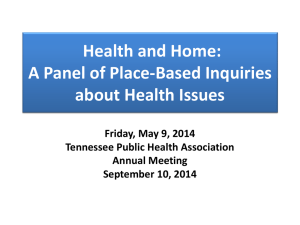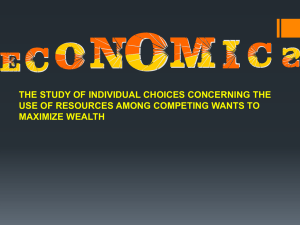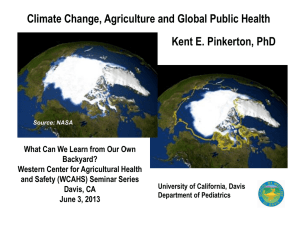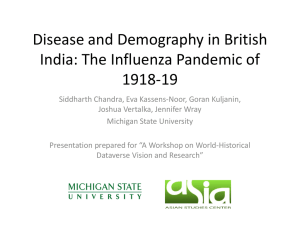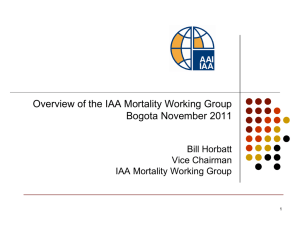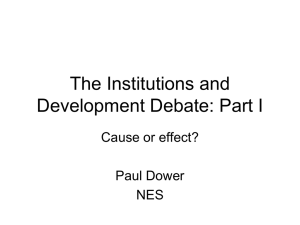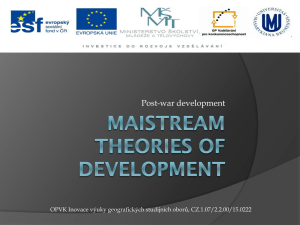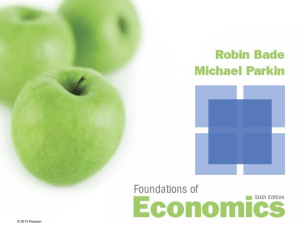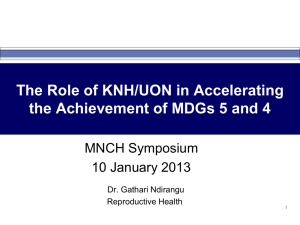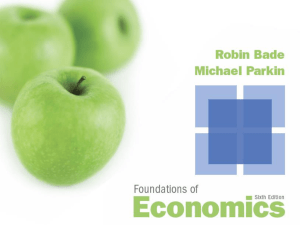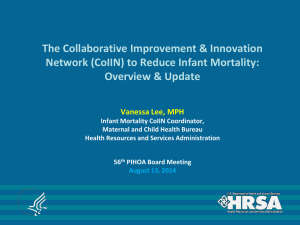Production of Health
advertisement
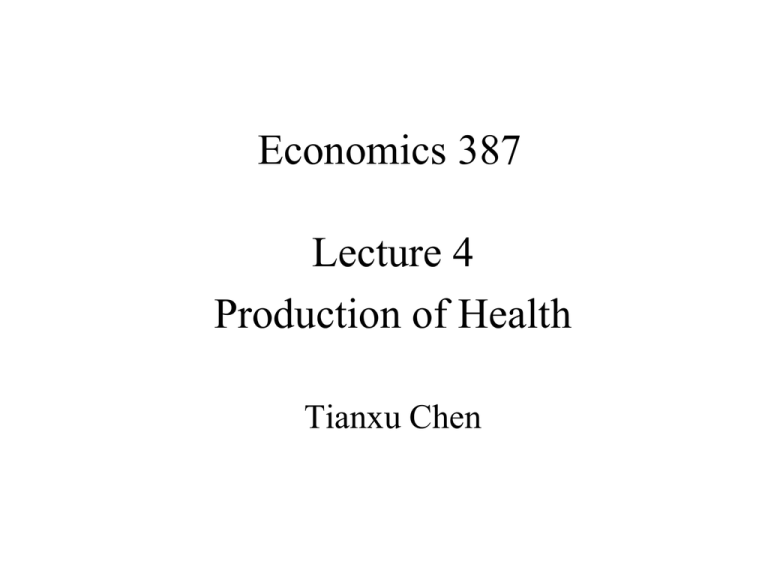
Economics 387 Lecture 4 Production of Health Tianxu Chen Outline • The Production Function of Health • The Historical Role of Medicine and Health Care • The Production Function of Health in the Modern Day • How Does Health Care Affect Other Measures of Health? • The Role of Schooling • Conclusions THE PRODUCTION FUNCTION OF HEALTH Definition: • The production function of health defines the relationship between health and the health inputs, like, practitioner provided health care, needed to produce health. Total Product • Health status increases as more and more health care inputs are added to the production process. Figure 5-1 Production of Health A Marginal Product • Diminishing marginal product – as more and more health care inputs are added to the production process, the increments in heath status diminish. Figure 5-1 Production of Health B Marginal Product and Health Care Policy • Often, the marginals, rather than the totals, are relevant to policy propositions. For example, no one seriously recommends that society eliminate all health care spending. However, it is reasonable to ask whether society would be better off if it could reduce health care expenditures by $1 billion and invest those funds in another productive use, such as housing, education, transportation, defense, or other consumption. Total v. Marginal • It is critical to distinguish between total and marginal contributions. It may turn out that although the total contribution may be substantial, the marginal contribution may be . Why do we care? • Because many decisions are made at the margin. Additions to the amount spent, may not be “worth it.” very small Marginal Products Under most conditions, marginal products are always going to be non-negative. Why? Can DH/Dx (where x = health care) be negative? <A> Yes! 2 Possibilities physician caused disease physician caused disease: All procedures have their risks. For example, in anesthesia, you kill someone a little bit -- You may do it too much. Suppose, that the more we do the higher the risk. More care gives lower marginal product, higher risk Examples of physician caused disease Examples: smallpox vaccine is a prime example; flu shots, for many, are another. Medical malpractice may be a third (i.e. the more done, the more possible mistakes). General Formulation HS = f (Health Care, Environment, Human Biology, Life Style) HS = f (HC, Env, HB, LS) If we’re concentrating on health care, Total Product: HS = f (HC, Env, HB, LS) Marginal Product: MP = DHS/DHC Average Product: AP = HS/HC HS = HCaAE1-a All Else 100 100 100 100 100 100 100 100 100 100 100 100 100 100 100 100 100 100 100 100 0.1 HC 1 2 3 4 5 6 7 8 9 10 11 12 13 14 15 16 17 18 19 20 HP Ave. Pr.Mgl. Pr. 63.1 63.1 67.6 33.8 4.5 70.4 23.5 2.8 72.5 18.1 2.1 74.1 14.8 1.6 75.5 12.6 1.4 76.6 10.9 1.2 77.7 9.7 1.0 78.6 8.7 0.9 79.4 7.9 0.8 80.2 7.3 0.8 80.9 6.7 0.7 81.5 6.3 0.7 82.2 5.9 0.6 82.7 5.5 0.6 83.3 5.2 0.5 83.8 4.9 0.5 84.2 4.7 0.5 84.7 4.5 0.5 85.1 4.3 0.4 90.0 80.0 70.0 60.0 Products a Total, Average, and Marginal Products 50.0 40.0 30.0 20.0 10.0 0.0 HP 0 5 10 Health Care 15 Ave. Pr.20 Mgl. Pr. THE HISTORICAL ROLE OF MEDICINE AND HEALTH CARE Overview • Many medical historians agree that practitionerprovided medical interventions played only a small, perhaps negligible, role in the historical decline in population mortality rates. • A larger role, one of the most significant ones, might be attributed to public health measures and the spread of knowledge of the sources of disease. • A number of scholars in this field attribute the largest share of the credit to improvements in environment, particularly to the greatly increased supply of foodstuffs that became available due to the agricultural and industrial revolutions. Rising Population and the Role of Medicine Figure 5-2 World Population from 10,000 BCE to Modern Day Source: http://www.ciese.org/curriculum/popgrowthproj/worldpop.html. Data from U.S. Census Bureau. On the Historical Role of Medicine and Health Care McKeown focused on dramatic rise in population in England and Wales since 1750. It seems that world population rose and fell without any upward trend, up until that time. How does population increase? (Discuss) <A> Increased births Decreased deaths Increased inmigration Did Medicine Cause the Decline in Mortality Rates? Figure 5-3 Fall in the Standardized Death Rate per 1,000 Population for Four Common Infectious Diseases in Relation to Specific Medical Measures for the United States Source: Reprinted from Milbank Memorial Fund Quarterly/Health and Society, John B. Mckinlay and Sonja M. Mckinlay, “The Questionable Contribution of Medical Measures to the Decline of Mortality in the United States in the Twentieth Century, Milbank Memorial Fund Quarterly/Health and Society 55 (1977): 405–428, with the permission of Blackwell Publishers. Did Medicine Cause the Decline in Mortality Rates? • In most cases, as the graph is shown, the availability of the effective medical intervention occurs well after the majority of the mortality declines. • Thus, the answer could be “probably no”. Public Health If not medical care, than what? Key point, though is increased nutrition Increased Nutrition “Infectious disease creates a relationship between host and parasite. While control of the parasite is directly helpful in reducing disease incidence, the condition of the host helps to determine its resistance to disease. A person who is better housed, better rested, and ... better fed, will be more resistant and less likely to die subsequent to exposure.” [FGS, Ch. 4] Medical Research? Useless? NO !!! Can provide disease origins Can address specific diseases Moreover, just because marginal impact isn’t big, it doesn’t mean that the total impact isn’t big. Nutrition Reduced Mortality • Two of the most respected students of the mortality decline, medical historian Thomas McKeown (1976) and economic historian Robert Fogel (2004), argued strongly that the main cause was improved nutrition. Public Health Reduced Mortality • Public health advocates claim contrary to McKeown that the major declines did not start until around 1870, and if they began this late, then public health, which began about 1850, would have come in time to contribute. What Lessons Are Learned from the Medical Historian? • We cannot conclude that medical research is unimportant in history or in the present day. • The argument regarding the role of medicine is a historical one, today, the arguments must be different. • Investments in medical research plays a major role in our health and well-being. What Lessons Are Learned from the Medical Historian? • Perhaps the best result of this overview is a healthy skepticism toward the effectiveness of any given medical practice, and more importantly, to its significance and benefit to the population. - Outcome studies; evidence-based medicine • These historical puzzles have relevance to the progress and public investment practices of lesser developed countries. THE PRODUCTION OF HEALTH IN THE MODERN DAY Preliminary Issues • Challenges with the measurement of health – mortality rates, morbidity rates or disability days? • Challenges with estimation biases due to the estimation of reduced form equations rather than structural equations. Measures of Health Status • Death rates (easiest to measure) • Healthy days • Morbidity rates It may be critical to distinguish between total and marginal contributions, since low marginals may accompany high totals. Table 5-2 Measuring the Contribution of Health Care to Population Health Elasticity of health expenditure = % chg. in health ÷ % chg. In health expenditures Is Health Care Worth It? • We have found that health care is a statistically significant contributor to health on the margin, but that its marginal effect on health is small. • Research suggests that the elasticity of health care at the margin is 0.10. Given current levels of expenditure on health care, a $100 billion expenditure on health care would result in an increase in life expectancy of 0.76 years spread over the population. Table 5-3 Contribution of Selected Factors to Reductions in Neonate Mortality Rates, 1964-1977 The World’s Pharmacies • Recent research (Shaw, Horrace, and Vogel, 2005; Miller and Frech, 2004) finds that Organization for Economic Cooperation and Development (OECD) countries with higher drug consumption have greater life expectancies. The magnitude of the effect is on a par with the effects of reduced cigarette consumption and increases of fruit and vegetables in the diet. Morbidity Mortality is useful because it is easy to measure. Morbidity refers to illness. What might we expect? If most diseases are either self-limiting, or irreversible, the possibilities for additional medical services to reverse morbidity are small. May work for some services (hypertension, periodontal disease), and not for others. That's about what is found. Morbidity • Mortality rates tell only part of the health care story, other measures of health also should be examined. These include morbidity data and other indicators of health. Work also is being done on developing a measure of the quality of life, and quality of life may become the subject of production studies. HOW DOES HEALTH CARE AFFECT OTHER MEASURES OF HEALTH Table 5-4 Work Loss Days per Employed Person per Year, by Plan RAND Experiment • The RAND Health Insurance Experiment (RHIE), one of the largest randomly controlled economic experiments ever conducted, discovered that the greater the portion of the health care bill that individuals are required to pay, the less health care they choose to purchase. The Importance of Lifestyle and Environment • Victor Fuchs studied the death rates in two states similar in many ways except lifestyle and environment, Nevada and Utah. The table to the right shows the excess death rate in Nevada compared to Utah. Table 5-5 Excess of Death Rates in Nevada Compared with Utah, Average for 1959-1961 and 19661968 Fuchs -- Utah/Nevada Excess Death Rates (Nevada - Utah) Age Group <1 1-19 20-39 40-49 50-59 60-69 70-79 Males 42% 16% 44% 54% 38% 26% 20% Females 35% 26% 42% 69% 28% 17% 6% Cigarettes, Exercise and a Good Night’s Sleep • Recent research (Balia and Jones, 2008; Contoyannis and Jones, (2004) addresses a common problem in studying human behavior by estimating both the determinants of lifestyle behaviors as well as the determinants of health status, giving a clearer picture of the importance of lifestyle. The authors showed that a good night’s sleep, avoiding smoking, and regular exercise each contribute importantly to selfreported health. The Family as Producer of Health • In understanding health impacts it may be valuable to view the family as a producer of health. Research (Rosenzweig and Schultz, 1983; Rosenzweig and Wolpin, 1995; Joyce, Racine, and Mocan, 1992; and Kaestner, Joyce, and Wehbeh, 1996) suggests that maternal lifestyle issues, like, smoking and drug use can negatively impact the production of newborn health. Social Capital and Health • Social capital may improve health in several ways: - it may relieve stress to have more beneficial social contacts - more contacts can provide additional information on healthful behaviors and health purchases - satisfying social relationships may provide reasons to reevaluate risky health behaviors Impact of Social Capital on Health • The research has produced a mixture of findings, but most support the hypothesis that social capital improvements lead to health improvements. Environmental Pollution • That pollution effects on health are sizable and statistically significant can be shown in both industrialized and lesser-developed countries (Cropper et al., 1997) Income and Health • Research by Deaton and Paxson (2001) examining in detail both U.S. and British data over time, they find the relation of income and health to be complex and contradictory. There was a substantial decline in mortality after 1950, but rather than growing incomes as the cause, they conclude that “a more plausible account of the data is that, over time, declines in mortality are driven by technological advances, or the emergence of new infectious diseases, such as AIDS” (p. 29). • Pritchett and Summers (1996) leave little doubt that extremely low incomes have a strong effect on people’s health. THE ROLE OF SCHOOLING Two Theories About the Role of Schooling • Michael Grossman’s (1972a, 1972b) theory of demand entails a central role for education. Grossman contends that better-educated persons tend to be economically more efficient producers of health status. • In contrast, Victor Fuchs (1982) has suggested that people who seek out additional education tend to be those with lower discount rates. Individuals with relatively low discount rates will be more likely to invest in education and in health as well. Empirical Studies on the Role of Schooling in Health • Recent evidence supports the view that education makes one a more efficient producer of health (Lleras-Muney, 2002). • Lleras-Muney’s study inspired new research of the effects of new laws extending the length of compulsory education in England and Ireland (Oreopoulus, 2006; Auld and Sidhu, 2005). These supported the earlier findings; an additional year of schooling caused an improvement in the affected student’s health. CONCLUSIONS • The health production function exhibits the law of diminishing marginal returns. • While the total contribution of health care is substantial, the marginal product is often small. • Historically the contributions of health care, at least as provided by the health practitioner, were probably small until well into the twentieth century. CONCLUSIONS • The small, modern-day marginal product of health care is statistically significant. • In the major, controlled health insurance experiment, the better insured exhibited little or no health gain from the extra health care they consumed. • Health care benefits people differentially and is generally more productive on the margin for women and blacks. CONCLUSIONS • Certain categories of health care have greater marginal effects on the population than others; prenatal care programs are examples of the more productive categories. • Education has a strong association with health status.

